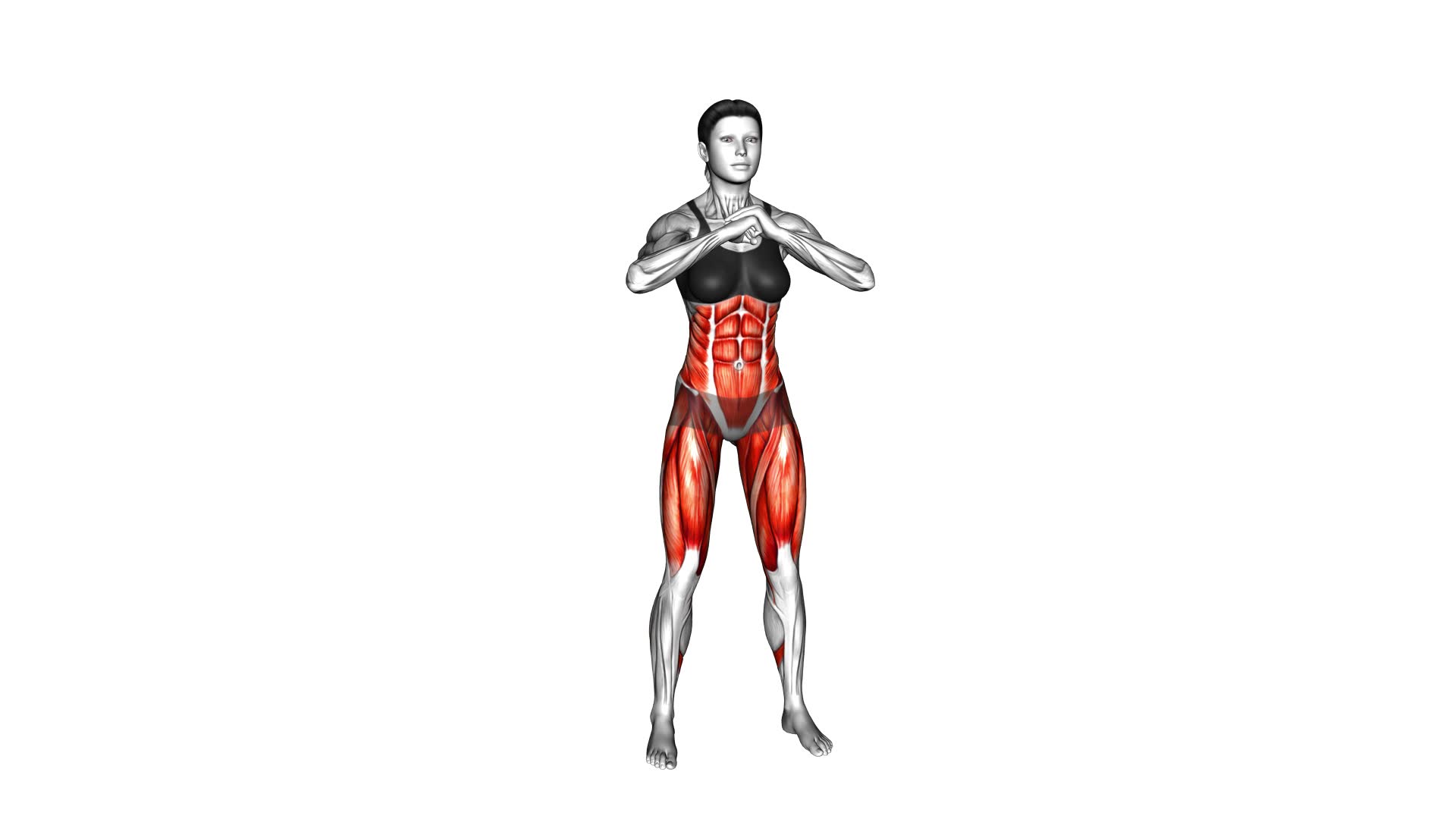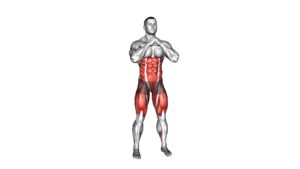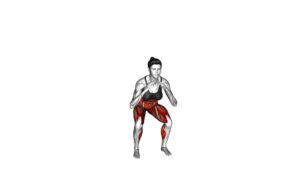Squat Side Power Kick (female) – Video Exercise Guide & Tips

Get ready to power up your workout with the Squat Side Power Kick! This exercise targets multiple muscle groups while improving your balance and flexibility.
Watch This Exercise Video
In this video exercise guide, we'll walk you through the proper form and technique to ensure you get the most out of each rep. Whether you're a beginner or advanced, we've got tips and modifications to challenge you at any fitness level.
Let's kick it into high gear and achieve those fitness goals!
Key Takeaways
- Targets multiple muscle groups
- Improves balance and flexibility
- Tones glutes, quadriceps, hamstrings, and calves
- Enhances overall balance and coordination
Benefits of the Squat Side Power Kick
Experience the numerous benefits of the Squat Side Power Kick, a dynamic exercise that strengthens your lower body and improves your overall fitness level. This exercise isn't only effective in toning your lower body but also in improving your balance. By incorporating the Squat Side Power Kick into your workout routine, you can target multiple muscle groups, including your glutes, quadriceps, hamstrings, and calves.
One of the key benefits of the Squat Side Power Kick is its ability to improve your balance. As you perform the exercise, you engage your core muscles to maintain stability, which helps to enhance your overall balance and coordination. This is particularly beneficial for activities that require stability, such as running, jumping, and playing sports.
Additionally, the Squat Side Power Kick is highly effective in toning your lower body. The explosive movement involved in this exercise targets your glutes, quadriceps, hamstrings, and calves, helping to sculpt and strengthen these muscle groups. By regularly incorporating this exercise into your routine, you can achieve leaner and more defined legs.
To perform the Squat Side Power Kick with proper form and technique, it's important to maintain a stable base by keeping your feet shoulder-width apart and your knees aligned with your toes. Engage your core muscles and squat down, keeping your chest lifted and your weight in your heels. As you come up from the squat position, extend one leg out to the side while simultaneously kicking with power. Remember to maintain control and balance throughout the movement.
Proper Form and Technique
To ensure proper form and technique for the Squat Side Power Kick, you need to focus on maintaining a stable base and engaging your core muscles.
This exercise requires balance and control, so it's important to avoid some common mistakes that can lead to injury.
One common mistake isn't maintaining a proper squat position. Make sure your feet are shoulder-width apart and your knees are aligned with your toes.
Another mistake isn't engaging your core muscles. Your core provides stability and power for the kick, so be sure to activate those muscles throughout the movement.
Lastly, avoid leaning too far forward or backward during the kick. This can throw off your balance and put unnecessary strain on your joints.
By paying attention to these key points, you can prevent injuries and get the most out of your Squat Side Power Kick.
Now that you understand proper form and technique, let's move on to preparing for the exercise.
Preparing for the Exercise
To properly prepare for the Squat Side Power Kick, you should continue to focus on maintaining a stable base and engaging your core muscles, as discussed in the previous section. Before attempting this exercise, it's important to perform a warm-up routine to increase blood flow to your muscles and reduce the risk of injury. A good warm-up can include dynamic stretches, such as leg swings and hip circles, to loosen up the joints and increase mobility.
Additionally, it's essential to be aware of common mistakes that people often make when performing the Squat Side Power Kick. One common mistake isn't maintaining proper form throughout the exercise. It's important to keep your back straight, shoulders relaxed, and knees aligned with your toes to avoid unnecessary strain on your joints.
Another mistake is neglecting to engage your core muscles. Your core provides stability and power for this exercise, so it's crucial to activate those muscles throughout the movement. Remember to draw your belly button in towards your spine and squeeze your glutes to create a solid foundation.
Step-by-Step Guide to Performing the Squat Side Power Kick
To perform the Squat Side Power Kick, continue to focus on maintaining a stable base and engaging your core muscles, as discussed in the previous section, while following these step-by-step instructions:
- Start by standing with your feet shoulder-width apart and your knees slightly bent.
- Lower your body into a squat position by bending your knees and pushing your hips back.
- As you come up from the squat, shift your weight onto your left leg and lift your right leg out to the side.
- At the same time, extend your right arm straight out to the side for balance.
- Kick your right leg out to the side, keeping it straight and engaging your glutes and hip muscles.
- Bring your right leg back to the starting position and repeat on the other side.
Squat Side Power Kick Modifications:
- If you have difficulty maintaining balance, hold onto a stable object, such as a chair or wall, for support.
- To increase the intensity, hold a dumbbell or kettlebell in your hand while performing the kick.
- For a lower impact version, perform the exercise without the jump.
Common Mistakes in Squat Side Power Kick:
- Allowing your knees to cave in during the squat phase.
- Not engaging your core muscles and relying solely on your leg strength.
- Failing to keep your back straight and chest lifted throughout the movement.
Tips for Maximizing Your Results
To maximize your results with the squat side power kick, it's crucial to focus on proper form techniques. This means maintaining a strong core, keeping your knees aligned with your toes, and engaging your glutes throughout the movement.
Additionally, incorporating effective training strategies such as gradually increasing the intensity, incorporating variations, and staying consistent will help you achieve the best possible results from this exercise.
Proper Form Techniques
To maximize your results, focus on maintaining proper form techniques during the Squat Side Power Kick exercise. This won't only help you achieve better results but also prevent common mistakes and reduce the risk of injuries.
Here are some tips to ensure you're performing the exercise correctly:
- Keep your feet shoulder-width apart and toes pointed slightly outward.
- Bend your knees and lower your body into a squat position, keeping your back straight and chest lifted.
- As you explode up from the squat, extend one leg out to the side, kicking with power and control.
Effective Training Strategies
To further enhance your results, incorporate these effective training strategies into your routine.
- First, focus on increasing your training intensity. This means pushing yourself to work harder during each workout session. By challenging your muscles and pushing them beyond their comfort zone, you can stimulate growth and improve muscle activation. You can achieve this by increasing the weight or resistance, reducing rest time between sets, or incorporating supersets and circuits into your training.
- Additionally, make sure to prioritize muscle activation during your exercises. This involves focusing on the specific muscles you're targeting and engaging them fully throughout each movement. By doing so, you can maximize the effectiveness of your workouts and achieve better results.
Now, let's explore variations and modifications for all fitness levels.
Variations and Modifications for All Fitness Levels
Now let's explore the different variations and modifications you can incorporate into the Squat Side Power Kick exercise to cater to all fitness levels.
Whether you're a beginner or an advanced fitness enthusiast, there are options available to suit your needs.
Beginners can focus on beginner-friendly modifications that allow them to gradually build strength and improve their technique.
Those seeking a challenge can try out advanced variations to push their limits and enhance their overall fitness level.
Beginner-Friendly Modifications
If you're a beginner looking to modify the Squat Side Power Kick exercise to suit your fitness level, there are several variations and modifications available.
Here are some options you can try:
- Reduced range of motion: Instead of kicking your leg up high, start with smaller kicks to gradually build strength and flexibility.
- Chair modification: If you have trouble with balance or lower body strength, you can perform the exercise while holding onto a chair for support.
- Hand support: Place your hands on a wall or sturdy surface to help maintain your balance as you perform the squat and kick movements.
These modifications are especially helpful if you have injuries or are modifying for different body types. Remember to listen to your body and go at your own pace. As you gain strength and confidence, you can gradually increase the intensity of the exercise.
Challenging Advanced Variations
Try incorporating the Plyometric Power Kick for a more challenging variation of the Squat Side Kick. This advanced modification adds an explosive element to the exercise, increasing power and intensity.
To perform the Plyometric Power Kick, start in a squat position with your feet shoulder-width apart. As you explode up, extend one leg straight out to the side, kicking with force.
Land softly back into the squat position and immediately repeat on the other side. This advanced training technique engages multiple muscle groups, including the glutes, quads, and core, while also improving cardiovascular endurance.
Be sure to warm up properly and gradually increase the intensity of your workouts to prevent injury.
Frequently Asked Questions
Can Men Also Perform the Squat Side Power Kick Exercise?
Yes, men can definitely perform the squat side power kick exercise. This exercise isn't limited to females and can be done by anyone looking to improve their lower body strength and flexibility.
To accommodate for differences in body structure and muscle mass, men may need to make variations and modifications to the exercise. It's important to consult with a fitness professional to ensure proper form and technique when performing this exercise.
How Many Calories Can Be Burned by Performing the Squat Side Power Kick?
When performing the squat side power kick, you can burn a significant amount of calories. The number of calories burned depends on various factors, such as your weight, exercise intensity, and duration. This exercise involves explosive movements, engaging multiple muscle groups, which can increase calorie burn.
The more intense your workout, the more calories you'll likely burn. Remember to consult with a fitness professional to determine the exact number of calories burned based on your specific circumstances.
Is It Necessary to Warm up Before Attempting the Squat Side Power Kick?
Before attempting the squat side power kick, it's important to warm up your body. Dynamic stretching is crucial to prepare your muscles and increase their flexibility. This will reduce the risk of injury and enhance your performance.
If you're looking for alternative warm-up exercises, you can try jogging in place, jumping jacks, or leg swings. Remember, warming up is essential to get the most out of your workout and ensure a safe and effective session.
Can the Squat Side Power Kick Help Improve Flexibility?
Yes, the squat side power kick can definitely help improve your flexibility. By incorporating this kick into your workouts, you're working on stretching and strengthening the muscles in your legs and hips, which can enhance your overall range of motion.
This increased flexibility can greatly benefit your kicking technique, allowing you to kick higher and with more power.
Are There Any Potential Risks or Injuries Associated With Performing the Squat Side Power Kick?
When performing the squat side power kick, it's important to be aware of potential risks and injuries. Without proper technique and precautions, you may strain your muscles, especially in the legs and hips.
To minimize the risk, ensure that you warm up properly, maintain good form, and don't push yourself too hard. It's also beneficial to start with variations that suit your current level of flexibility and gradually progress.
Conclusion
Incorporating the squat side power kick into your workout routine can provide numerous benefits, including increased leg strength, improved balance, and enhanced cardiovascular endurance.
By following proper form and technique, you can maximize the effectiveness of this exercise. Remember to start with a suitable warm-up and progress at your own pace.
Whether you're a beginner or advanced fitness enthusiast, there are variations and modifications available to suit your fitness level.
So, get ready to kick your fitness goals into high gear with the squat side power kick!

Author
Years ago, the spark of my life’s passion ignited in my mind the moment I stepped into the local gym for the first time. The inaugural bead of perspiration, the initial endeavor, the very first surge of endorphins, and a sense of pride that washed over me post-workout marked the beginning of my deep-seated interest in strength sports, fitness, and sports nutrition. This very curiosity blossomed rapidly into a profound fascination, propelling me to earn a Master’s degree in Physical Education from the Academy of Physical Education in Krakow, followed by a Sports Manager diploma from the Jagiellonian University. My journey of growth led me to gain more specialized qualifications, such as being a certified personal trainer with a focus on sports dietetics, a lifeguard, and an instructor for wellness and corrective gymnastics. Theoretical knowledge paired seamlessly with practical experience, reinforcing my belief that the transformation of individuals under my guidance was also a reflection of my personal growth. This belief holds true even today. Each day, I strive to push the boundaries and explore new realms. These realms gently elevate me to greater heights. The unique combination of passion for my field and the continuous quest for growth fuels my drive to break new ground.



